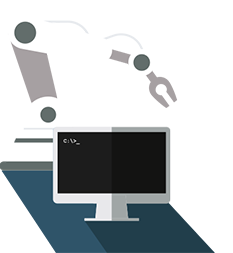Webinars on "Digital manufacturing Research results from occupational safety and health"
How can artificial intelligence support the safety inspection of machines? What does the increasing digitalization of human-machine interaction mean…
Read moreDigital Manufacturing

Digital manufacturing is the application of digital technologies to manufacturing, having the right information, at the right place, at the right time.
The goal is to link disparate systems and span processes across all departments and functions within the value chain. By doing so, each stakeholder gains quicker access to more accurate data, allows higher customization of product, producing smaller batch, generate cost savings, workplaces are becoming more ergonomic and health is being promoted. It is not always about product but also services.
Nevertheless, convergence of the information technology (IT) and operational technology (OT) is potential increasing the cyber risk, connecting historically isolated production systems with enterprise IT infrastructure. This shift often opens potential vulnerabilities, creating conduits for malware to enter the organization through end user workplace devices e.g. spear-phishing. One of the biggest risks facing manufacturers today is the potential disruption of production services as a result of a cyber-attack.
This bring new opportunities and challenges for safety and health at work in the world of work, in production and application. Safety in the broadest sense refers to both physical security (safety) and IT or cyber security (security).
The approach of the Section Machine and System Safety is to make available documents with simple solutions and examples to reduce those risks.
Each individual element of the system Human - Machine - Environment may be the cause of system failure and thus lead to risks. In Cyber Physical Systems additional risks from digitization must be analysed and assessed.
The digital transformation is about rethinking processes and activities in a digital way. It offers opportunities for occupational safety and health to make workplaces even safer but causes also risks. By networking a large number of safety devices, for example, areas can be better monitored and safeguarded. The safe remote control of machines is another example and can also lead to dangerous work processes being carried out safely without causing hazards for people. It is therefore important that occupational safety and health guides digital manufacturing from the very beginning.
In all these considerations, industrial security must be an essential element. Processes that can be changed by unauthorized access would have a negative impact on occupational safety.
How can artificial intelligence support the safety inspection of machines? What does the increasing digitalization of human-machine interaction mean for occupational safety? How robust is Industry 4.0 against cyberattacks? These and other questions will be addressed by international experts in a digital lecture series developed by the IFA in cooperation with the Section Machine and System Safety of the International Social Security Association (ISSA).
Every Monday afternoon from April 15, 2024, you can look forward to an exciting hour of lectures and discussions in English. Registration is not necessary, you can simply dial in via the registration link to the WebEx conference. Please note that the starting time varies!
Read more: https://www.dguv.de/ifa/veranstaltungen/vortragsreihe-digital-manufacturing/index-2.jsp
Always with the focus on how safety and health at work is connected to industrial security we plan to discuss relevant issues and give practical examples and advice on the following topics:
The structure for this guide to a safety & security checklist describes measures on 4 different levels:
Partners for any of those tasks are welcome.